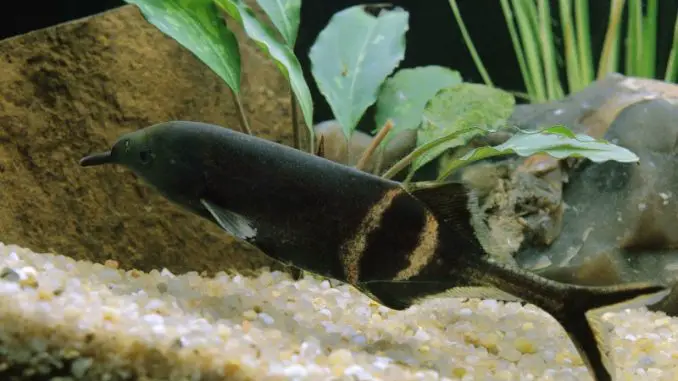
The elephant nose fish, or elephant fish, is a freshwater fish species in the family Mormyridae. Elephant nose fish have long, pointed noses and gray, skinny bodies.
With its active nature and unique appearance, the elephant fish is a popular fish with aquarists, despite its aggressive tendencies.
TABLE OF CONTENTS
Elephant Nose Fish Facts & Overview
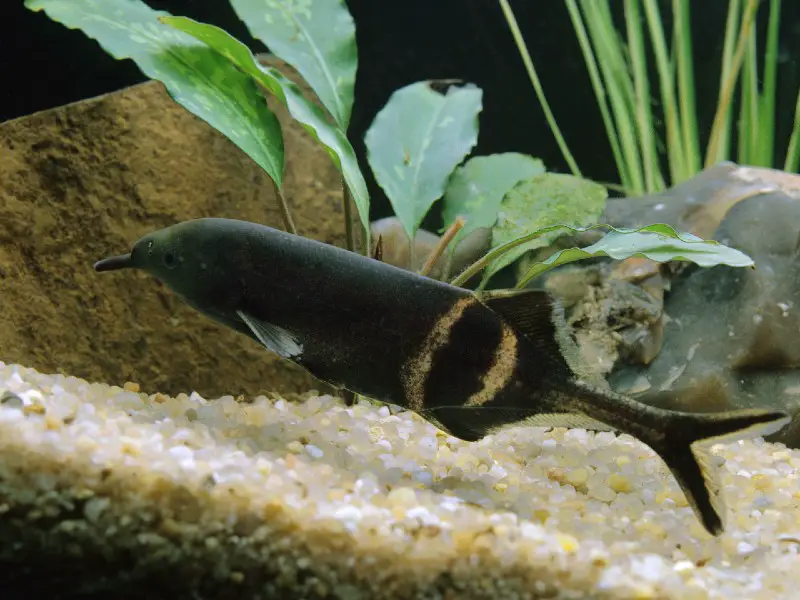
| Scientific name: | Gnathonemus petersii |
| Common names: | Eelephant nose fish, elephant fish, elephantnose fish, Peters’s elephant nose fish, long-nosed elephant fish, ubangi morymid |
| Distribution: | Africa |
| Size: | 7–10 inches |
| Life expectancy: | 6–9 years |
| Color: | Gray with an elongated snout |
| Diet: | Carnivore |
| Temperament: | Semi-aggressive |
| Minimum tank size: | 50 gallons |
| Temperature: | 73–82°F (23–28°C) |
| pH: | 6.5–7.2 |
| Hardness: | 5–15 dGH |
| Care level: | Moderate |
| Breeding: | Egg-layer |
Origin
Elephant nose fish originate from regions in Africa, namely the Chari River in the Central African Republic and the Ogun River and Niger River in Nigeria.
The elephant nose fish’s natural habitat is filled with vegetation, natural debris, and thick substrate. The fish has adapted to be able to feel around obstacles with its long nose — known as a schnauzenorgan — which is highly sensitive to smell and touch.
In the wild, elephant fish spend a lot of time digging amongst roots, plants, rocks, logs, and branches to find food.
Adult Size & Lifespan
Elephant nose fish grow to about ten inches long. In the wild, some elephant fish grow up to 13 inches long, but captive elephant fish stop growing at nine inches long. Females are larger and have more rounded abdomens than males.
The average lifespan of an elephant nose fish is six to nine years.
Availability
Although elephant nose fish are sold at the most popular online fish stores, they’re often out of stock. These fish aren’t as popular as other freshwater fish species due to their large size and unique care needs.
The typical cost of an elephant nose fish is $15–$25.
Elephant nose fish are available at the following online aquatic stores:
Appearance & Behavior
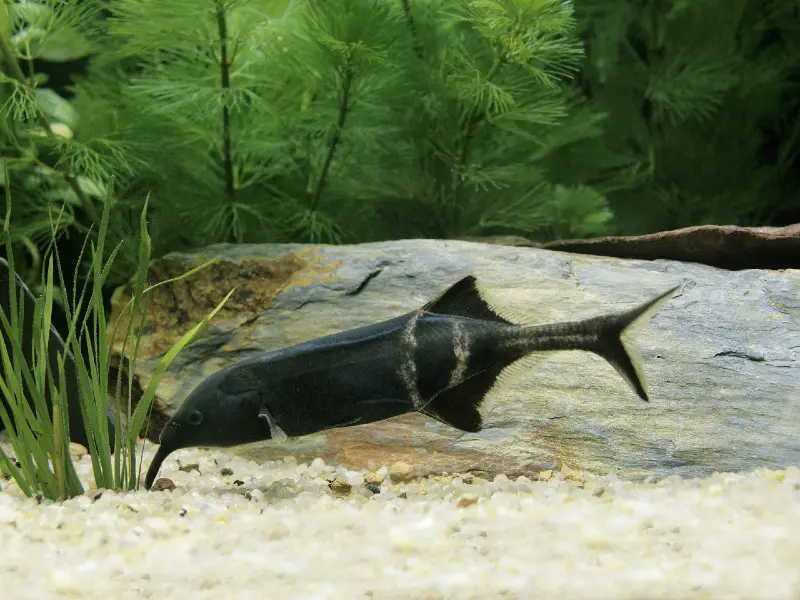
Elephant fish have long gray bodies with elongated noses. The fish are peaceful when housed with large compatible fish species, but display aggressive tendencies to small fish and other elephant fish.
Colors, Patterns, Fins, and Sex Differences
Despite its dull gray or brown coloring, the elephant fish is a popular aquarium fish due to its distinctive, uniquely-shaped body.
The elephant fish’s long, pointed nose resembles an elephant’s trunk and the long sword on the snout of a swordfish. Its nose has a subtle curve at the end, pointing towards the ground. The fish’s nose connects with its mouth, allowing the elephant fish to reach into deep cracks and crevices to find food.
The elephant fish has an almost-scaleless skinny body, with one or two vertical white stripes encircling the body towards the tail end. The fish has two dorsal fins — the first fin is protected by a large spine — and large pectoral fins.
Elephant fish have two-gill openings in front of the pectoral fins on each side of their bodies. The tail of the elephant fish is long and narrow.
Typical Behavior
Elephant nose fish are highly active, spending much of their time in the bottom of the tank, digging amongst the substrate for food. In the wild, the elephant fish is most active in the evening, but in a dimly-lit aquarium, the fish is active during the day.
When housed with large, peaceful tank mates, elephant fish are quiet, non-aggressive fish that keep to themselves.
However, elephant fish are aggressive and territorial when housed with other elephant fish, and the fish are known to bully small shy fish in the aquarium. Nipping, chasing, and fighting during feeding time are some boisterous behaviors exhibited by elephant fish.
Elephant Fish Care & Tank Requirements
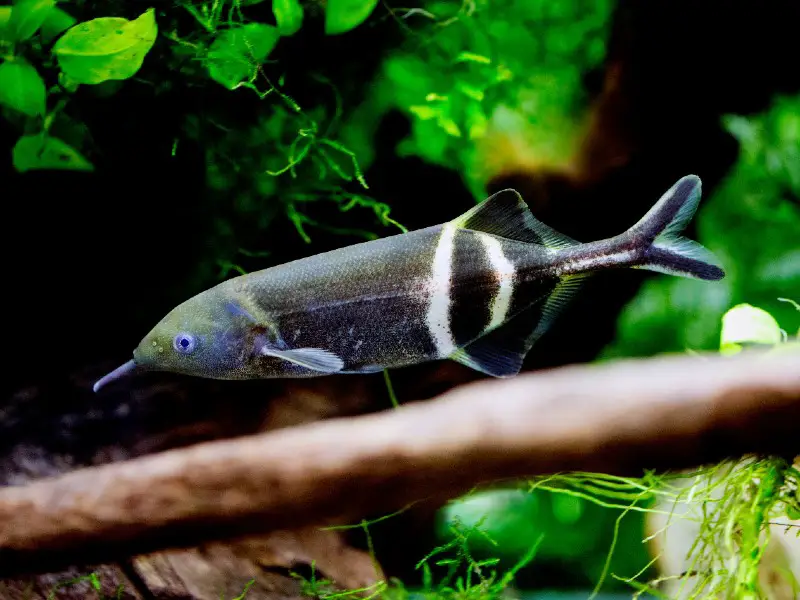
Elephant fish have several care needs that beginners could struggle with. they are best suited to experienced aquarists who can provide the ideal tank environment, carnivorous diet, and tank mates for the fish.
Habitat and Tank Requirements
The elephant fish’s natural habitat is murky tropical waters with a deep substrate. Provide a similar environment in the tank to keep your elephant fish busy fulfilling its natural urge to hunt for food.
Because the elephant fish is a large species, the tank should be at least 50 gallons, providing plenty of open swimming space. Ensure the tank is tall to allow for deep substrate at the bottom of the tank.
Add a thick layer of sand to the bottom of the tank, topped with branches, logs, plants, rocks, and roots. Don’t use abrasive substrates, like sharp gravel, which could scrape the fish’s nose and lead to infection.
Choose plants that thrive in low-light conditions, and plants that grow in sand, such as anubias, Java fern, and Amazon sword. Ensure the tank is well-planted to provide hiding places for the fish.
Elephant nose fish are used to murky, low-light conditions, so aquarium lighting should be dimmed throughout the daytime hours. Duckweed and Java moss are good floating plants that block out light in the aquarium.
Add large caves and hollow tank decorations for elephant fish to hide and sleep in.
Tank Conditions
The ideal tank conditions for elephant fish are:
| Water type: | Neutral, slow-moving freshwater |
| Tank size: | Minimum 50 gallons |
| Water temperature: | 73–82°F |
| Substrate: | Fine sand or crushed coral |
| Tank setup: | Plants, logs, roots, rocks, caves |
| Acidity: | 6.5–7.2 pH |
| Water hardness: | 5–15 dGH |
| Filter: | Yes, elephant fish are sensitive to poor water conditions, so a high-quality filter is an essential |
| Bubbler: | Yes, to oxygenate the tank |
| Lighting: | Yes, dim lighting is needed to mimic the fish’s day-to-night cycles |
| Water heater: | Yes, to maintain a warm water temperature |
Elephant nose fish are highly sensitive to changes in water parameters, especially pH.
Acidic or alkaline water causes stress and disease in elephant fish. Buy an electronic pH meter to test your aquarium’s pH daily and ensure it remains neutral. Ensure the tank is algae-free and clean the walls and decorations regularly.
Disease
Elephant fish aren’t prone to specific diseases, but the fish are highly sensitive to changes in water temperature, foods, plants, and medications, and such changes increase their vulnerability to disease.
Some of the diseases affecting elephant fish are:
Columnaris
Columnaris, or cotton mouth disease, is caused by a gram-negative bacterium. This disease invades the skin on the fish’s head region, causing lesions around the mouth, gray spots, fuzzy patches on the body, and discolored scales. If left untreated, columnaris eventually leads to death.
Treat columnaris with antibiotics or chemicals recommended by your veterinarian.
Skin and Gill Flukes
Skin and gill flukes are worm-like parasites that live and reproduce in a fish’s skin and gills. The parasites drill holes in the fish’s flesh that commonly lead to secondary bacterial infections. Parasites also take on oxygen and, in large numbers, cause oxygen starvation. Symptoms of skin and gill flukes are flashing (rubbing against rough surfaces), lethargy, rapid breathing, and loss of appetite.
Treat skin and gill flukes with fluke treatments like praziquantel.
Other common aquarium diseases that affect elephant fish are Ich and fin rot. Signs of Ich are white spots on the body and flashing (rubbing against rough surfaces). Fin rot causes ragged, frayed, milky fins.
Treat ich by raising the temperature of the water and adding aquarium salt to the tank. Treat fin rot with anti-fungus treatment recommended by your veterinarian.
Tank Mates
Elephant fish are calm and peaceful when housed with the right tank mates. Don’t house elephant fish with small, shy fish, or invertebrates like shrimp, which are likely to be bullied or eaten by elephant fish. Avoid housing multiple elephant fish together because the fish are known to fight and injure one another.
Ideal tank mates for elephant fish are large, peaceful fish that require the same water parameters as elephant fish. They include:
- Congo tetras
- Large species of gouramis (sparkling gouramis, pearl gouramis, honey gouramis)
- Discus
- Angelfish
- Cory catfish
- Bichirs
- Black ghost knife fish
Diet and Feeding
In the wild, elephant nose fish eat a carnivorous diet of small meaty foods such as shrimp, larvae, insects, and worms. Feed the fish a similar high-protein diet in captivity.
Bloodworms and small pieces of shrimp are good live or frozen foods to include in an elephant fish’s diet. To ensure the fish’s diet is mixed and varied, provide tubifex, larvae, and earthworms.
Protein-rich fish flakes and pellets can be included in the elephant fish’s diet, but live foods are a more nutritious choice and should be prioritized.
Feeding elephant fish is easy. The fish enjoy eating, and training the fish to eat from your hand is possible.
Provide a pinch of food three times per day. Allow some food to sink to the bottom of the tank, because elephant fish enjoy searching for food in the substrate.
Breeding
The majority of elephant nose fish are wild-caught, and there have been no reports of successful captive-bred elephant fish.
Identifying the gender of the fish is almost impossible. Housing a group of elephant fish together, assuming that at least one fish must be a different gender from the rest, is too risky, because the fish attack one another in close confinement.
Attempting to breed elephant fish isn’t recommended. There isn’t enough information available on how to successfully breed the fish.
Should You Get an Elephant Nose Fish for Your Aquarium?
Elephant fish are unique, active fish that are a lot of fun to watch in a home aquarium.
Consider getting an elephant fish for your aquarium if you can provide a tank tailored to this fish, with ideal water parameters and a deep substrate.
Don’t get elephant fish if you’re new to fishkeeping or you plan to add the fish to a tank that is tailored to another, non-compatible fish species.
Despite their moderate care needs, elephant fish are popular aquarium fish, providing plenty of entertainment for an experienced fishkeeper.

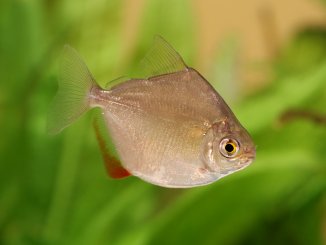
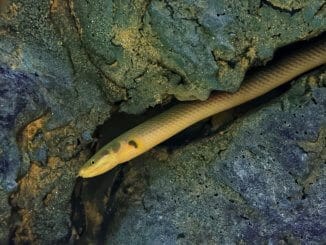
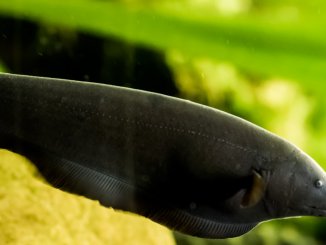
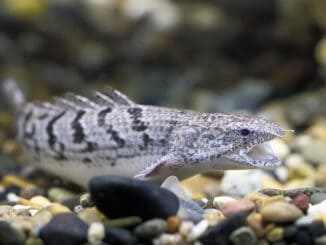
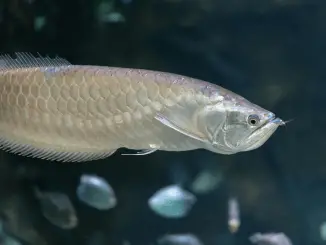
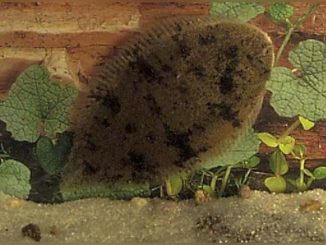

Be the first to comment